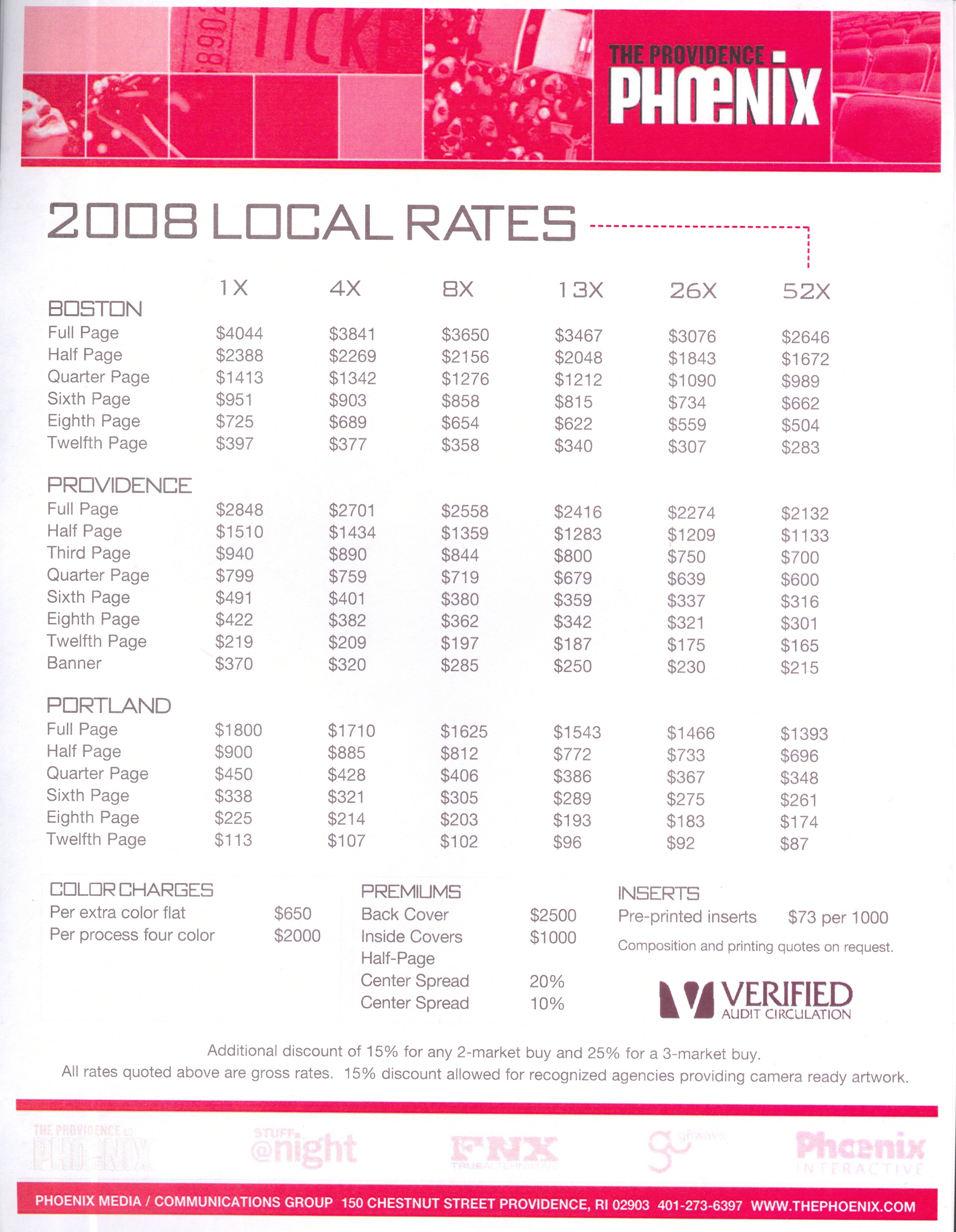"Reader surveys have astonished even publishers with the revelation that the roving eyes of newspaper readers take equal satisfaction in ads and news copy." --McLuhan 282
Through the medium of a newsweekly, advertisers are given the opportunity to present their products as part of the larger social processes of the community. For example, a full-page advertisement for upcoming concerts at Lupo's, printed in full color, seems of equal importance to the adjacent article about Rhode Island senate candidates. The mosaic represents the community, and advertisements are an integral part of this mosaic. Also, it cannot be forgotten that it is the ads that make the entire publication possible. Without the revenue from advertisers, the Phoenix would not be able to exist as a free publication. Because they make up the majority of color images in a given issue of the paper, ads are also key to grabbing and holding on to the reader's attention.
While the narrative style of articles in the Phoenix undeniably promotes a particular point of view, the promotional power of advertisements, represented by images rather than text, is also great. The inclusion of ads in such a publication contributes to the "corporate image... of the community in action" and invites "maximal participation in the social process" (McLuhan, 306). Being a maximal participant entails everything form voting in elections to attending local concerts to being an active local consumer.
In order to make the consumption of advertising as convenient as possible, the Phoenix strategically places ads alongside corresponding articles and reviews. For example, the club listings section is interspersed with ads for local clubs and venues, while the Film section is full of ads for upcoming movies and theaters. Ads for local restaurants are found in the "Dining Out" section. The more expensive, full-page, color ads--often for national chain companies such as American Apparel--are strategically placed either just inside the front cover or in the very middle. The middle pages of the paper are frequented by readers, because in order to remove the Arts and Entertainment section from the paper one must first turn to the middle.
When I visited the Providence Phoenix headquarters on Chestnut Street in downtown Providence, I had the opportunity to meet with Providence's associate publisher Stephen Brown. I asked him who the target audience was for Phoenix readership and he promptly informed me--after giving the old once-over--that the target audience was ME. Flattered to think that the entire operation laid out before me was meant to cater to my needs and interests, I couldn't help but smile. The specific demographics of Phoenix readers, which are laid out in the Phoenix's advertising promotion bundle, add up to an advertiser's dream. As Stephen Brown pointed out bluntly, "When you're childless, you can do whatever you want wherever you want!" Put simply, the educated, well-off, young, single reader is the ideal target for advertisers, who crave the attention of those who are interested in new products and venues and have the time to shop, party and go out to dinner.
In an attempt to boast its popularity among educated readers, the Phoenix advertising bundle dedicates an entire page to advertising opportunities just within the Phoenix's quarterly Education supplement. Catered to continuing education programs looking to advertise themselves, the supplement boldly states: "For over 40 years, The Phoenix has been the preferred paper of the educated 21-35-year-old crowd in Boston, Providence and Portland... Our readers want to know about you! Regular Phoenix readers are 71% more likely to further their education in the next 12 months than the market average (that's more than the Boston Metro, 42%, and more than the Dig, Boston Magazine, Improper Bostonian, and Sunday Globe combined, 11%)." Backed by statistics, the Phoenix can direct its attention to a very specific group likely to benefit from advertising in it.
When I asked Brown about the merits of producing a free publication rather than one which charges for subscriptions, he explained that the revenue from selling subscriptions to a newspaper usually only ads up to about 5% of the total revenue. This means that for any publication, the biggest responsibility falls on the advertisers to get a positive response from their advertising. Although subscription newspapers have the added expense of distribution of their product, the cost of distribution is minimal in comparison to the costs of production and hiring. As Brown put it, "Printing and people: those are your biggest expenses."

Above are listed the prices for full, half, quarter, sixth, eighth and twelfth page advertisements in the Boston, Providence and Portland branches of the Phoenix. Note that it is significantly cheaper to advertise in Providence than in Boston, and cheaper still to advertise in Portland. The bottom of the sheet lists extra charges for color, pre-printed inserts, and "premium" spots. Premium spots are more expensive because they encompass the most frequented sections of any paper: back cover, inside covers, and full and half-page center spreads. Another popular spot for advertising is the listings section of the paper. Although listings are not printed near the front of the publication, many readers flip to them immediatly to find dates and times of shows and addresses for various clubs and venues.
Back to Form: paper, ink and the mosaic, We the local businesses
